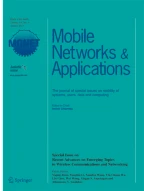Abstract
This study investigates the feasibility of using Long Term Evolution (LTE) cellular networks for the real-time smart grid state estimation. The smart grid state estimation requires measurement reports from different nodes installed in the smart grid. Therefore, the uplink LTE radio delay performance is selected as key performance indicator for the collection of the desired measurements. The analysis is conducted for two types of measurement nodes, namely Smart Meters (SMs) and Wide Area Monitoring and Supervision (WAMS) nodes, installed in the (future) smart grids. The SM and WAMS measurements are fundamental input for the real-time state estimation of the smart grid. The LTE delay evaluation approach is performed via ‘snap-shot’ system level simulations of an LTE system where the physical resource allocation, modulation and coding scheme selection and retransmissions are modelled. The impact on the LTE delay is analyzed for two different LTE resource allocation approaches, namely, simple random scheduler with fixed LTE physical resource allocation per user, and time-based LTE scheduler with flexible LTE physical resource allocation per user. The results show that time-delay prioritized scheduling in combination with flexible PRB assignment greatly reduces the maximum delay when compared to simple random scheduling and fixed PRB assignment. This type of scheduling approach and flexible PRB allocation is recommended for supporting time critical smart grid applications within LTE.
Similar content being viewed by others
Notes
For example, if an operator would allocate 10% of a 10 MHz LTE carrier for supporting smart grid traffic then NTOTAL, PRB = 0.1 × 50 = 5 PRBs.
In LTE the minimum time needed for a transmitter to realize its previous transmission is erroneously received and needs to be re-transmitted is 8 TTIs.
As the MCS is selected so that the BLER is kept below 10% it is assumed that in average 5% of the transmissions will be erroneously received.
References
3GPP TR 36.912 version 12.0.0, feasibility study for further advancements for E-UTRA (LTE-Advanced), September 2014
3GPP TS 36.213, Evolved Universal Terrestrial Radio Access (E-UTRA); Physical layer procedures (Table 8.6.1–1 and Table 7.1.7.2–1)
5G Infrastructure Association, 5G and energy, white paper, Version 1.0, 30 September 2015
Adamiak M, Premerlani W, Kasztenny B. Synchrophasors: Definition, Measurements, and Application, available for download at https://www.gedigitalenergy.com/
Dimitrova DC, van den Berg JL, Heijenk G, Litjens R. (2011) LTE uplink schedulink-flow level analysis, Multiple Access Communications Lecture Notes in Computer Science 6886
FP7 SUNSEED, Deliverable D2.1.1, preliminary requirements and architectures for DSO-telecom converged communication networks in dense DEG smart energy grid networks, July, 2014
FP7 SUNSEED project Deliverable D3.1, Traffic modelling, communication requirements and candidate network solutions for real-time smart grid control, April 2015, available for download from http://sunseed-fp7.eu/deliverables/
Horsmanheimo S, Maskey N, Tuomimaki L, Feasibility study of utilizing mobile communications for smart grid applications in urban area, IEEE International Conference on Smart Grid Communications (SmartGridComm), Venice, Italy, November 3–6, 2014
IEC 61850–5. Communication networks and systems for power utility automation – part 5: Communication requirements for functions and device models, January 2013
Jorguseski L et al. LTE delay assessment for real-time Management of Future Smart-Grids, 1st EAI SmartGIFT conference, Liverpool, UK, May 19–20 2016
Karupongsiri C, Munasinghe KS, Jamalipour A, Random access issues for smart grid communications in LTE networks, 8th International Conference on Signal Processing and Communication Systems (ICSPCS), Gold Coast, Australia, December 15–17, 2014
Litjens R, Toh Y, Zhang H, Blume O (2014) Assessment of the energy efficiency enhancement of future mobile networks, proceedings of WCNC 14, Istanbul, Turkey
Lixia M. IEEE 1588 synchronization in distributed measurement Systems for Electric Power Networks, PhD Thesis, University of Cagliari, March 2012
Louvros S, Paraskevas M, Triantafyllou V, Baltagiannis A LTE uplink delay constraints for smart grid applications, 19th IEEE International Workshop on Computer Aided Modeling and Design of Communication Links and Networks (CAMAD), Athens, Greece, December 1–3, 2014
Maskey N, Horsmanheimo S, Tuomimaki L, Analysis of latency for cellular networks for smart grid in suburban area, 5th IEEE PES innovative smart grid technologies Europe (ISGT Europe), Istanbul, Turkey, October 12-15, 2014
Mavenir, Latency considerations in LTE, White paper, September 2014
Motorola. (2008) 3GPP contribution R1–081638, TBS and MCS Signaling and Tables
Nagai Y, Zhang L, Okamawari T, Fujii T. Delay performance analysis of LTE in various traffic patterns and radio propagation environments, 77th IEEE Vehicular Technology Conference (VTC Spring), Dresden, Germany, June 2–5, 2013
Nokia Siemens Networks LTE-capable transport: a quality user experience demands an end-to-end approach, Whitepaper, 2011
Yuzhe Xu, Fischione C. Real-time scheduling in LTE for smart grids, Communications Control and Signal Processing (ISCCSP), 2012 5th International Symposium on, May 2012
Zhang L, Okamawari T, Fujii T Performance evaluation of end-to-end communication quality of LTE, 75th IEEE Vehicular Technology Conference (VTC Spring), Yokohama, Japan, May 6–9, 2012
Acknowledgments
We thank all the colleagues from the FP7 SUNSEED project consortium for the numerous discussions that were useful input for the study presented in this paper.
Funding
This work is partly funded by the FP7 SUNSEED project, with EC grant agreement no: 619437.
Author information
Authors and Affiliations
Corresponding author
Rights and permissions
About this article
Cite this article
Jorguseski, L., Zhang, H., Dijkstra-Soudarissanane, S. et al. LTE Delay Assessment for Real-Time Management of Future Smart Grids. Mobile Netw Appl 24, 1742–1749 (2019). https://doi.org/10.1007/s11036-018-1050-y
Published:
Issue Date:
DOI: https://doi.org/10.1007/s11036-018-1050-y
